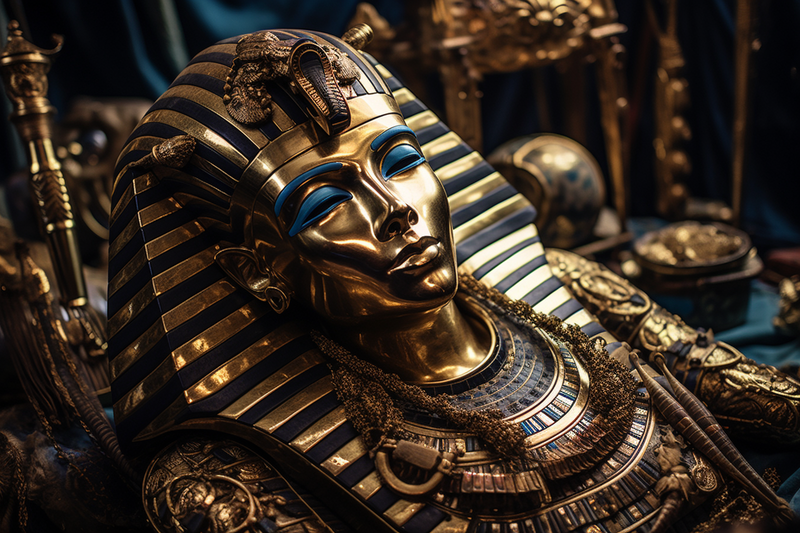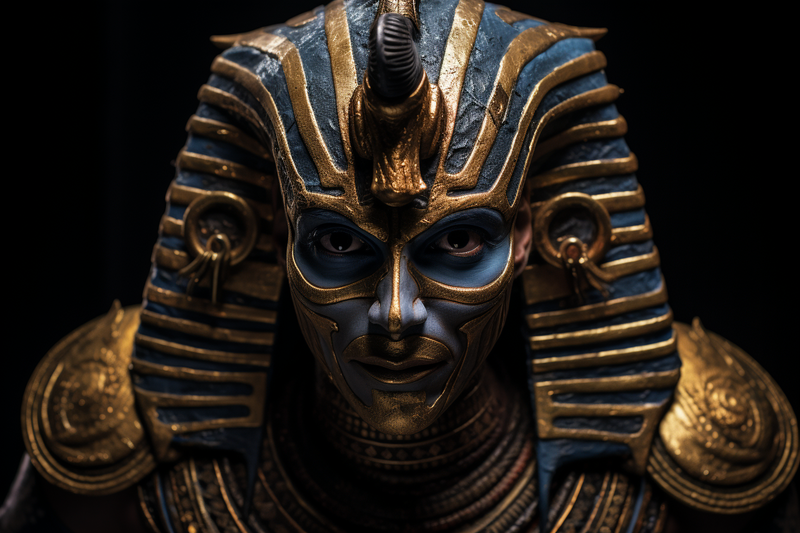
The whisper of ancient curses and dark magic echo through the sands of time, their chilling resonance felt by those daring enough to challenge the eternal slumber of Pharaohs. Our tale begins in the year 1922, in the heart of Egypt, where a grand discovery was about to unleash a nightmarish chain of events. This is the story of the Curse of the Pharaohs, a tale interwoven with death, fear, and the inexplicable.
In the golden realm of King Tutankhamun’s tomb, silence guarded the secrets of the young Pharaoh, its reign undisturbed for over three millennia. But with the intrusion of eager archaeologists prying open the doors of his eternal chamber, it was said that a malevolent curse was unleashed, one that ushered in a reign of mysterious deaths and unending horror.
Unveiling the Curse
King Tutankhamun, the boy king, held reign for a mere decade, but his name would echo through eternity. His tomb, discovered by British archaeologist Howard Carter, was a time capsule preserving the grandeur of ancient Egypt. Yet, it was believed that with the breaking of the Pharaoh’s seal came a terrible curse, a supernatural punishment for those who dared to disturb his rest.
The curse, as the whispers went, bore a terrifying prophecy, “Death shall come on swift wings to him who disturbs the peace of the King.” From this moment, a macabre shadow seemed to fall upon those who were involved in the tomb’s unveiling, a shadow that carried the chilling hint of ancient revenge.
Victim Profiles
The first to fall prey to the supposed curse was Lord Carnarvon, Carter’s financial backer, who died just months after the tomb’s opening. The cause? A seemingly innocuous mosquito bite that turned septic. But believers argue that the truth was far more sinister, that he was the curse’s first victim. His death was followed by a series of unexplained deaths, all linked to those who had first entered the boy king’s burial chamber.
One by one, the curse claimed its victims. George Jay Gould I, a visitor to the tomb, died of a fever following his visit. Then, Carter’s secretary Richard Bethell was found dead under mysterious circumstances. His father, Lord Westbury, despaired by the death of his son, allegedly leaped to his death from a building, leaving a note that read, “I really cannot stand any more horrors.”
Each death added a layer of dread to the theory of the curse, creating an eerie narrative that raised the question – were these deaths mere coincidence, or were they indeed the wrath of a disturbed King echoing from the afterlife? As we venture further into this chilling tale, the line between the two becomes ever more blurred.
Evidence Supporting the Curse
The believers in the curse point towards the unnerving sequence of deaths as irrefutable evidence of its existence. It was as if an invisible specter hovered over those who dared to enter the tomb, exacting revenge for the Pharaoh. Adding to the chilling narrative are numerous accounts of strange occurrences and ominous phenomena surrounding these deaths.
For instance, when Lord Carnarvon succumbed to his fate, legend says that back in England, his pet canary was swallowed by a cobra. The symbolism was not lost on those following the tale; the cobra being a royal symbol in ancient Egypt, it was as if the Pharaoh’s wrath had reached far beyond his crypt.
There were also reports of Carter’s house being haunted by ghostly apparitions and unexplained phenomena after the tomb’s opening. And the day of Carnarvon’s death was allegedly marked by a blackout in Cairo and the inexplicable howling of his dog back at his home estate in England.

Sceptics and Counter-Evidence
Despite the eerie tales and unsettling deaths, many skeptics argue that the Curse of the Pharaohs is merely a product of overactive imaginations and sensationalist media. They challenge the curse on various grounds, the most significant being the absence of any explicit curse inscriptions in Tutankhamun’s tomb.
Scientists offer alternative explanations for the mysterious deaths. They propose that exposure to toxins, like mold or bacteria present in the tomb, could have led to illnesses in those present during its opening. Such theories ground the curse in the realm of science, distancing it from the supernatural.
Moreover, skeptics point out that Howard Carter, the man who violated the Pharaoh’s rest by opening the tomb, lived for more than a decade after the discovery. If a curse was indeed unleashed, why was Carter, the main transgressor, seemingly spared its wrath?
Yet, despite these rational explanations, the Curse of the Pharaohs persists, its chilling narrative refusing to be quelled, continuing to haunt our collective consciousness. After all, not everything can be explained away by logic and science. Some things, particularly those of a terrifying nature, remain stubbornly inexplicable.
Psychological Impact and Cultural Implications
The Curse of the Pharaohs has permeated deep into popular culture, its chilling tale shaping countless movies, books, and documentaries. There is an undeniable allure to its narrative, a mixture of dread and fascination. After all, it combines the human fascination with ancient civilizations, the allure of undiscovered secrets, and the fear of the supernatural – all potent ingredients for psychological horror.
This tale’s impact transcends beyond entertainment. It reveals our collective fear of the unknown, our dread of the irreversible consequences of crossing unseen boundaries. The curse symbolizes a punishment for humanity’s hubris, for delving into places where we perhaps do not belong.
Conclusion
In the final analysis, whether you lend credence to the Curse of the Pharaohs or dismiss it as mere folklore is a matter of personal belief. What is undeniable, however, is the enduring impact of this story, the dread it continues to inspire, and the questions it provokes.
Have we truly uncovered the secrets that the ancient tomb of Tutankhamun holds, or are we just scratching the surface, oblivious to the deeper, darker truths buried within? Could the sequence of deaths be mere coincidence, or are they the manifestation of a supernatural retribution exacted upon those who disturbed the sacred peace of a Pharaoh?
These questions linger, hanging heavily in the air like the dust particles that once billowed from the tomb’s seal. Despite our best attempts at rational explanations, the eerie spectre of the curse refuses to dissipate, continuing to haunt the annals of our shared history. Even in the glaring light of scientific scrutiny, the shadowy corners of the unknown persist, leaving room for a lingering dread that sends an icy shiver down our spine.
DISCLAIMER: All Conspiracy Theories on this site are provided to form as fictional articles intended to be seen by the reader in the same was as an Urban Legend or Creepypasta. The views expressed in this article are not endorsed by our website. Our intent is to explore this theory from a horror and fiction perspective. While the information related to the theory is accurate, it should not be construed as confirmation or proof of its validity. We encourage readers to approach such theories with a critical and open mind.


